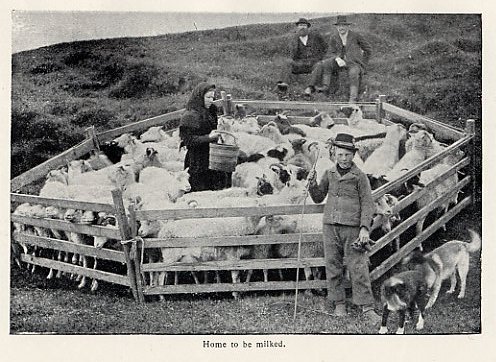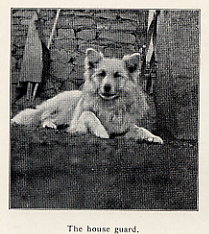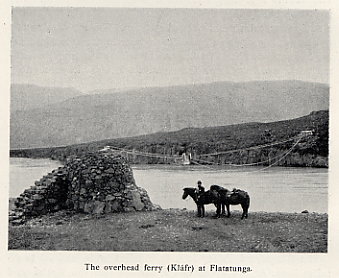| |
SKAGAFJORDS DALE
is divided by Hjeradsvotn, a large swollen river, drawing
its waters from the melted ice from Hofsjokull, and from
'hill and dale. The valley is noted for its fine meadows; its
magnificent frame of hills, — especially on the east side,
where numberless small dales break into the hills —; and
in fact for its pretty scenery in general. Three or four rows
of farms lie in the meadows on the slopes, principally on
the west side. An exceptional breed of horses is raised in
this verdant valley and the traveller who is fortunate enough
to procure his mount from here will not regret it.

Home to be milked
The summer is short in Iceland, far too short, and no
time must be lost if all the necessary work is to be got
through betimes. First and foremost the hay must be saved,
for fodder for the cows, horses and sheep for the winter is
an essential for these, and consequently for the Icelanders
themselves. Agriculture is scarcely known in Iceland. The
traveller who traverses the valleys of Iceland in the summer
sees therefore haymakers, men and women together, hard
at work in the home fields of the farms or in the meadows;
he hears every where the sharpening of the scythes and
sees their rythmic swing, or he meets the ponies loaded with
large bundles of hay and being led in single file by a youth
or girl, who is often mounted on the leader. May be the girl
is sitting astride a mans saddle, red-cheeked and bonny and
unconscious of impropriety. When the little caravan reaches
home to the farm the hay is stacked in long ricks in the
hay-yard or is put in sheds.
Away up the hillsides are the milch sheep, generally ten-
ded by an old man or a boy (smali). Towards evening the
flock is driven home to the farm to be milked and the sing
song cry of the shepherd, as he sends his dog up after them,
may be heard.
The cows are run in the meadows or on the hills, and the
horses likewise; but far far away on the other side of the
fell many miles from the farms — and away up on the
highland plain which stretches towards the Glaciers, sheep and
colts run wild the whole summer through.
On a Sunday all work ceases — unless the hay harvest
makes it absolutely necessary to work — and the scythes
and rakes find a resting place on the roofs of the houses.
The people dress themselves, catch and saddle up the
horses — and off they go at a rare pace to church. The women
take the smallest children with them on the saddle, those
a little older are secured on their own horses, and the big-
ger ones ride of themselves, the boys with their feet stuck
in the stirrup straps in lieu of stirrups. The dogs bring up
the rear. And so from all the farms a procession moves
churchward over stick and stone and brook and beck. They
meet early at the church, for there is much to talk over:
The old ask the news, the young — they soon find one
another and many a promise which bound for life and death,
is given here in the churchyard among the grass-grown
graves and crumbling crosses.
But the women, before entering the church pay a visit to
the farm hard by, to lay aside their cloaks and hats or
riding bonnets, and fasten the little tasselled caps on their
heads; or perhaps, if it is a special festival, even to deck
themselves out in the proper festal garb. This custom is
however on the wane in the villages.

The house guard.
old Icelandic churches built of turfs, they may
be found in the church itself under the roof. The last of
these old churches are to be found in Skagafjords dale.
A choir is often formed of young women who lead the
singing. They are all attractive, and neatly clad in becoming
dresses.
The day before one may have seen them in their work-a-
day attire raking hay in the home-fields, with dishevelled
locks partly confined by a handkerchief at the back of the
head, and with short skirts and thick brown woolen stockings
fastened at the knee with leather garters. Firmly and boldly
they marched about their work, smartly and ably they sprang
over the ditches and puddles in their skin shoes.
Now the clergyman enters the pulpit; he reads his sermon,
the usual practice in Iceland. After the service there may
be Holy Communion or a Christening: though seldom the
latter, for the children are generally christened at home. If
the Parsonage is near the church it may happen that coffee
is provided for the congregation in the "Badstofa". This
room is without ceiling. The windows are in the roof, and
there is a row of bedsteads along each side; there is seldom
a stove, but it is easily kept warm in the winter when all
the farm hands are there, and all the lamps lighted. This
room is both living room and sleeping room for all
engaged on the farm, married and single, youths and maidens.
Such an arrangement could scarcely be dreamt of in
Reykjavík or at the trading stations, but in the country this old
custom is still adhered to, and yet morals are in no way
worse here than where such indiscriminate mixing of the
sexes is unheard of. Force of habit is so strong that young
girls without shame undress and go to bed in the same
sleeping room as the men.
Sometimes the end of the "Badstofa" is partitioned off,
and the master of the house and his wife sleep here. The travel-
ler however is generally accomodated in the "Stofa", a small
dwelling house apart; but attendants and guides usually sleep
in the common room.
Finally one little party after another mount their horses.
The swains especially start off at a furious pace, while the
girls hop boldly into the saddle and follow them.
A Sunday calm rests over the valley. There is no sound
of sharpening scythes, no caravan with hay, no load
homeward bound from the trading station. Only the merry
mounted party wending home from church. Almost imperceptibly
the wind stirs the grass on the roof of the old church —
on the graves beside it, and on the roof of the farm house
where the watch dog lies on guard. Up in the hills a fog
encircles the highest peak; but down in the broad
meadows by the rivers winding course, and on the dark clumps
of houses, whence the blue smoke rises aloft, the sun shines,
— and out on the horizon the blue sea is roaring.
Sunday evening comes. Here and there a neighbourly call
is being paid at an adjacent farm. In the late twilight hours,
when the hay is smelling sweetly in the home fields the
callers finally mount their horses and turn their heads home-
ward.
The Skagafjord Valley is 6 to 8 miles wide and 20 to 25
miles long. At the upper end it divides into the Eystri- and
Vestridalur, long deep and narrow valleys uninhabited at
their upper ends nearest Hofsjokull. From these valleys come
the east and west glacier streams, the principle tributaries
to Hjeradsvotn. Gradually the river reaches out of the
hills into the more open country, and finally at its mouth
it is split in two by the large Island Hegranes. Throughout
its whole course however it is rapid and deep, and can only
be forded at a couple of places and not even there at all ti-
mes. Ferries, overhead ferries, fords, and bridges are used
in communication between the two valley-sides. These are
to be found at the following places:
| |
Fording place in Eystridalur opposite Aboer, and at one
point farther up in the uninhabited part.
Bridge in Vestridalur at Goddalir.
Overhead Ferry (Kláfr) at Flatatunga.
Ford opposite Silfrastadir.
Ford opposite Miklibær.
Ferry-boat "Akraferja" between Flugumýri and Vidimýri.
Bridge over the east arm of Hjeradsvotn below Hofstadir
and finally.
Ferry-boat over the west arm of Hjeradsvotn, west of He-
granes, an old Thing place.
|
At the ferries the loose horses often swim over, while the
people and pack-horses go on the ferry-boat. The ferrymans

The overhead ferry (Kláfr) at Flatatunga.
helper is on the spot active and smart at helping. The
horses which are not packed are driven out into the water with
stones. They keep together in a bunch with their heads
upstream, so that the weaker horses swim in the lee of the
stronger; snorting and groaning, with wide-stretched nostrils
they swim gamely over. The moment they reach shore they
shake the water from them and roll in the sand, then off to
the nearest pasture.
FROM SAUDARKROKR TO GILHAGI
there is a choice of the two following routes:
1) Along the west side of the valley, passing
Hafsteinsstadir, — Reynistadir, — Glaumbær, — Vidimyri (church
built with Turfs), — and Moelifell; one day
2) Along the east side of the valley including a side trip to
Holar, the old episcopal residence; two days.
1st Day: Saudarkrokr — Hegranes Hofstadir Holar (church)
and back to Hofstadir (Turf church), where is
to be spent the night.
2nd Day: Hofstadir— Flugumýri (Turf church) — Miklibær
— Silfrastadir — over Nordurá ford —
Flatatunga — by overhead ferry over Hjeradsvötn
and from there to Gilhagi. From the ferry one
must first ride about 1 1/2 hours in a southerly
direction, before it is possible to turn W NW
towards Gilhagi, because the country is very
swampy on the road direct towards Gilhagi from
the ferry.
3) Finally a combination of these two routes may be made,
making use of ferries, bridges and ford. This will take
two days.
Excursions in Eystri- and Vestridalur from Gilhagi take at
least two days. Here are a number of deserted dwellings
dating from the middle-ages, proving that the settlements
at that period stretched much deeper into the country than
at the present day.
|
|





![]() Zurück zu Inhalt
Zurück zu Inhalt![]() nächstes Kapitel
nächstes Kapitel